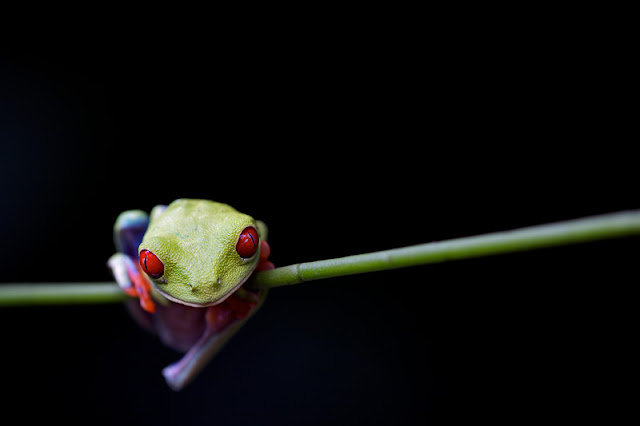 |
Red-Eye Tree Frog - Caribbean Slope, Costa Rica
Canon 5D Mark II + Canon 180mm MacroL |
What follows is a retelling of the Zen view of Past - Present - Future...
Strolling through a bamboo forest, a zen monk is consumed by the beauty and harmony in nature. He banks left through a narrow wood and sees a tiger in the distance. Fearful of his fate, the monk begins to run. Instinct, adrenaline and hunger makes the tiger give chase. The tiger bounds through the forest with ease and begins to approach the monk who now labors with every step.
Fleeing with all of his speed, the monk discovers that it is all about to end. You see, the forest terminates at a cliff.
Giving little thought to the ramifications of his actions, the monk hurls himself over the edge. As gravity pulls him down he spots a tree snag emerging from a rocky shelf. Reaching out, the monk catches the snag and rejoices in his good fortune.
The tiger, frustrated, now sniffs at the monk from above, while the monk ponders a way to descend the remaining 15 feet. Looking down, the monk now observes that another tiger has arrived and waits from below.
Thinking he will wait them out, the monk secures his body to the branch that now hangs precariously between the two hungry tigers. It is at this point that two mice scurry out of a crevice in the mountain and begin to gnaw away at the branch.
From the corner of his eye, the monk spots a ripe, red, and luscious strawberry growing on a nearby vine. He Grasps a the tendrils of the plant in one hand, and plucks the strawberry with the other. Tossing the ripe fruit into his mouth, the monk thinks to himself.... delicious.
Zen teaches us that we can’t run from our past nor fear our future, rather, we must embrace and savor the now.
The way I see it, photography is about the experience. We need to learn how to silence the peripheral noise that clutters our minds, unlock the shackles of our past, and worry less about the future. Grab a camera, find some light, and live the moment.
©2000-2012 BTLeventhal.com / Bruce & Tamy Leventhal. All rights reserved. No image on this site may be used without permission.






















